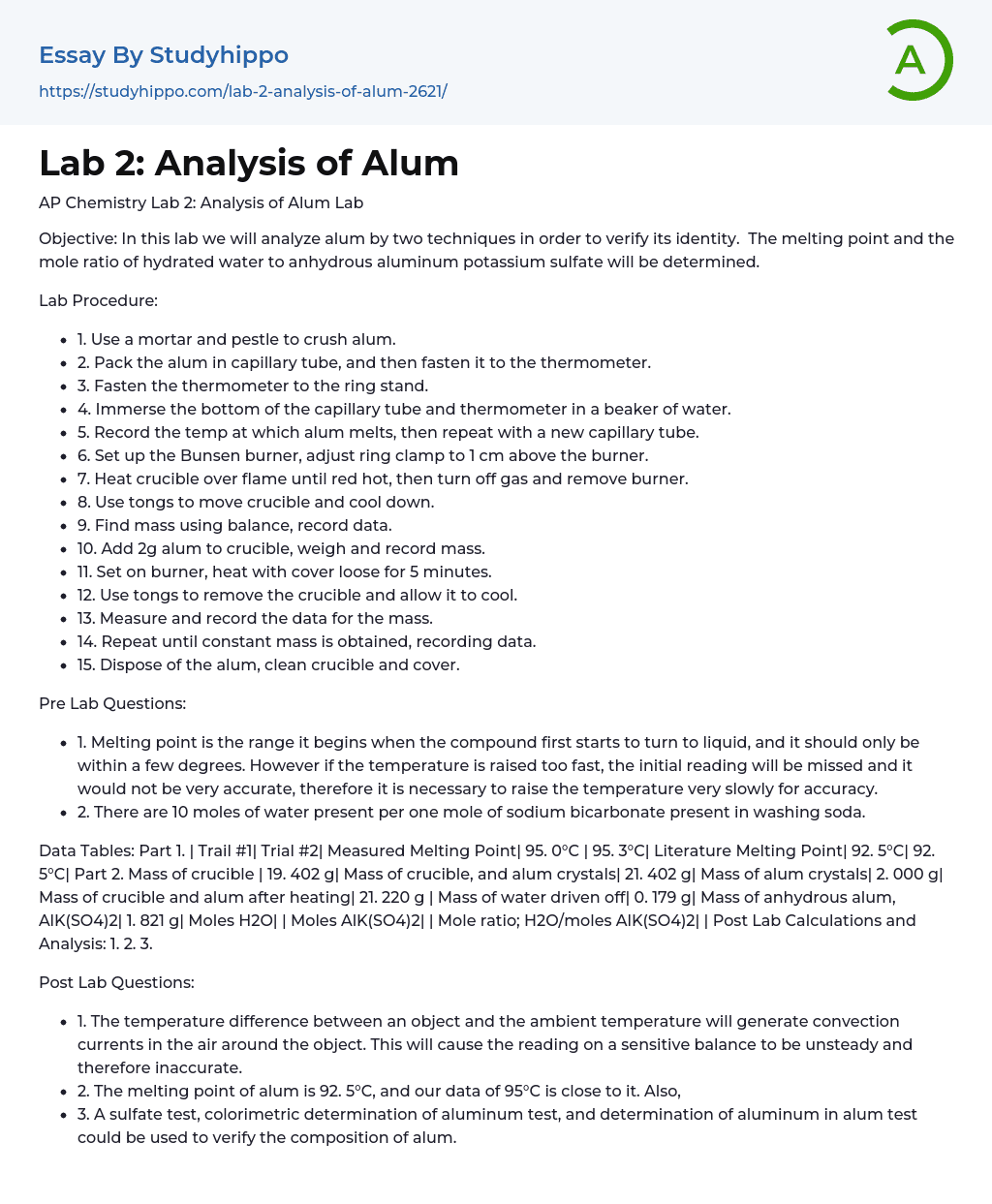Text preview
Objective: In this lab we will analyze alum by two techniques in order to verify its identity. The melting point and the mole ratio of hydrated water to anhydrous aluminum potassium sulfate will be determined.
Lab Procedure:
- Use a mortar and pestle to crush alum.
- Pack the alum in capillary tube, and then fasten it to the thermometer.
- Fasten the thermometer to the ring stand.
- Immerse the bottom of the capillary tube and thermometer in a beaker of water.
- Record the temp at which alum melts, then repeat with a new capillary tube.
- Set up the Bunsen burner, adjust ring clamp to 1 cm above the burner.
- Heat crucible over flame until red hot, then turn off gas and remove burner.
- Use tongs to move crucible and cool down.
- Find mass using balance, record data.
- Add 2g alum to crucib
...le, weigh and record mass.
- Set on burner, heat with cover loose for 5 minutes.
- Use tongs to remove the crucible and allow it to cool.
- Measure and record the data for the mass.
- Repeat until constant mass is obtained, recording data.
- Dispose of the alum, clean crucible and cover.
Pre Lab Questions:
- Melting point is the range it begins when the compound first starts to turn to liquid, and it should only be within a few degrees. However if the temperature is raised too fast, the initial reading will be missed and it would not be very accurate, therefore it is necessary to raise the temperature very slowly for accuracy.
- There are 10 moles of water present per one mole of sodium bicarbonate present in washing soda.
Post Lab Questions:
- The temperature difference between an object
View entire sampleJoin StudyHippo to see entire essay
and the ambient temperature will generate convection currents in the air around the object. This will cause the reading on a sensitive balance to be unsteady and therefore inaccurate.
Popular Essay Topics
- Accounting essays
- Marketing essays
- Automation essays
- Business Cycle essays
- Business Model essays
- Business Operations essays
- Business Software essays
- Corporate Social Responsibility essays
- Infrastructure essays
- Logistics essays
- Manufacturing essays
- Multinational Corporation essays
- Richard Branson essays
- Small Business essays
- Cooperative essays
- Family Business essays
- Human Resource Management essays
- Sales essays
- Market essays
- Online Shopping essays
- Selling essays
- Strategy essays
- Management essays
- Franchising essays
- Quality Assurance essays
- Business Intelligence essays
- Corporation essays
- Stock essays
- Shopping Mall essays
- Harvard Business School essays
- Harvard university essays
- Trade Union essays
- Cooperation essays
- News Media essays
- Waste essays
- Andrew Carnegie essays
- Inventory essays
- Customer Relationship Management essays
- Structure essays
- Starting a Business essays
- Accounts Receivable essays
- Auditor's Report essays
- Balance Sheet essays
- Costs essays
- Financial Audit essays
- International Financial Reporting Standards essays
- Tax essays
- Accountability essays
- Cash essays
- Principal essays




